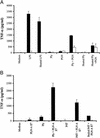Recognition of pneumolysin by Toll-like receptor 4 confers resistance to pneumococcal infection
- PMID: 12569171
- PMCID: PMC149942
- DOI: 10.1073/pnas.0435928100
Recognition of pneumolysin by Toll-like receptor 4 confers resistance to pneumococcal infection
Abstract
Streptococcus pneumoniae is one of the leading causes of invasive bacterial disease worldwide. Fragments of the cell wall and the cytolytic toxin pneumolysin have been shown to contribute substantially to inflammatory damage, although the interactions between pneumococcal components and host-cell structures have not been elucidated completely. Results of a previous study indicated that cell-wall components of pneumococci are recognized by Toll-like receptor (TLR)2 but suggested that pneumolysin induces inflammatory events independently of this receptor. In this study we tested the hypothesis that pneumolysin interacts with surface proteins of the TLR family other than TLR2. We found that pneumolysin stimulates tumor necrosis factor-alpha and IL-6 release in wild-type macrophages but not in macrophages from mice with a targeted deletion of the cytoplasmic TLR-adapter molecule myeloid differentiation factor 88, suggesting the involvement of the TLRs in pneumolysin recognition. Purified pneumolysin synergistically activated macrophage responses together with preparations of pneumococcal cell walls or staphylococcal peptidoglycan, which are known to activate TLR2. Furthermore, when compared with wild-type macrophages, macrophages from mice that carry a spontaneous mutation in TLR4 (P712H) were hyporesponsive to both pneumolysin alone and the combination of pneumolysin with pneumococcal cell walls. Finally, these TLR4-mutant mice were significantly more susceptible to lethal infection after intranasal colonization with pneumolysin-positive pneumococci than were control mice. We conclude that the interaction of pneumolysin with TLR4 is critically involved in the innate immune response to pneumococcus.
Figures






References
-
- World Health Organization. Wkly Epidemiol Rec. 1998;73:187–188. - PubMed
-
- Zangwill K M, Vadheim C M, Vannier A M, Hemenway L S, Greenberg D P, Ward J I. J Infect Dis. 1996;174:752–759. - PubMed
-
- Centers for Disease Control and Prevention. Morbid Mortal Wkly Rep. 1997;46:1–24. - PubMed
-
- Tuomanen E, Tomasz A, Hengstler B, Zak O. J Infect Dis. 1985;151:535–540. - PubMed
-
- Tuomanen E I. Ann NY Acad Sci. 1996;797:42–52. - PubMed
Publication types
MeSH terms
Substances
Grants and funding
LinkOut - more resources
Full Text Sources
Other Literature Sources
Medical
Molecular Biology Databases

